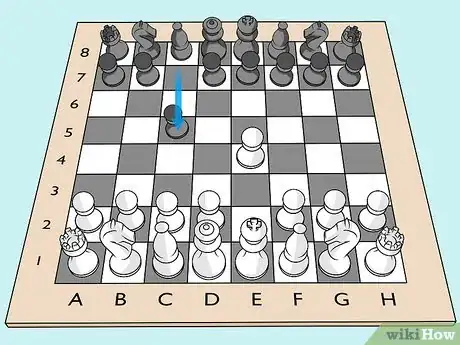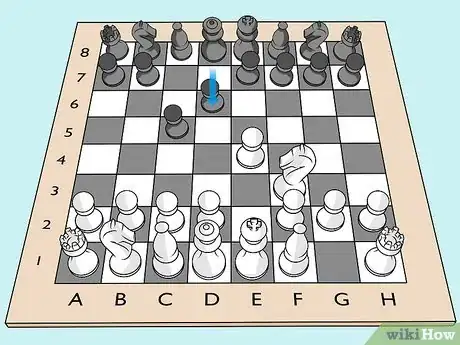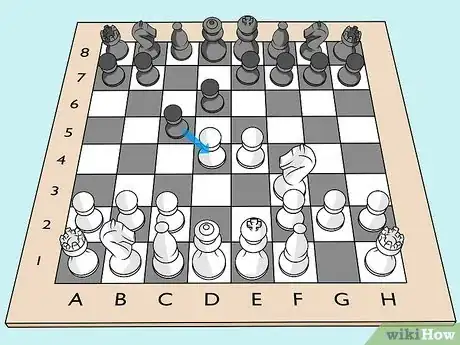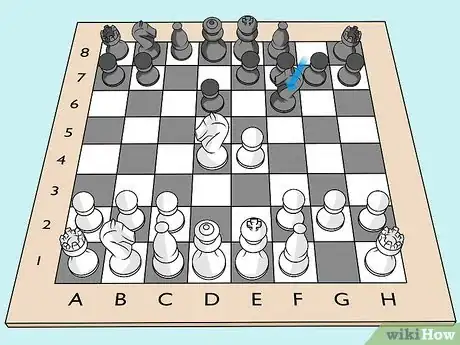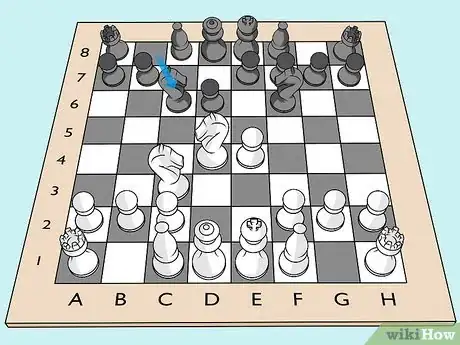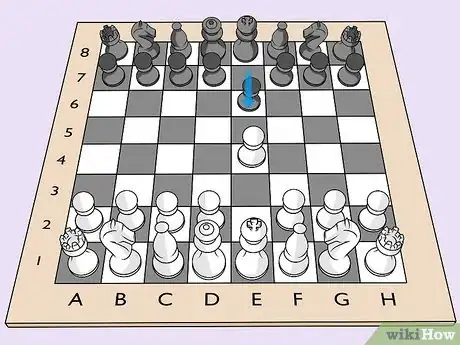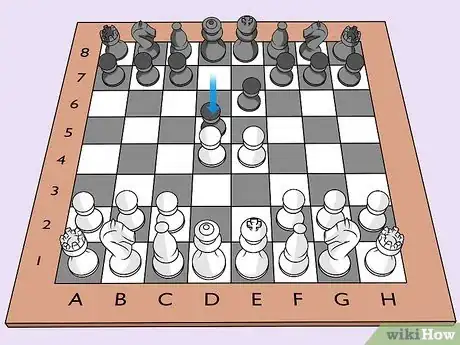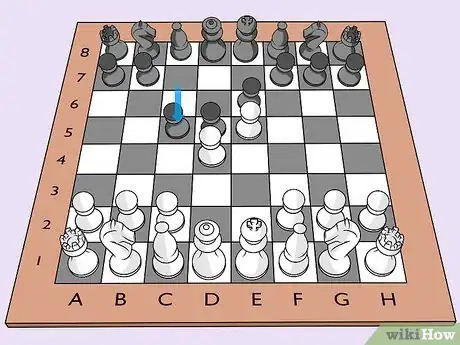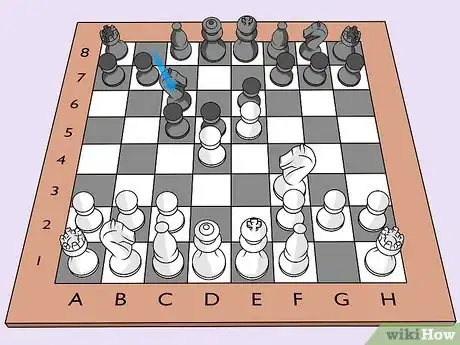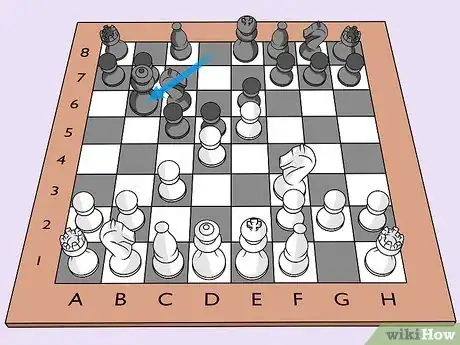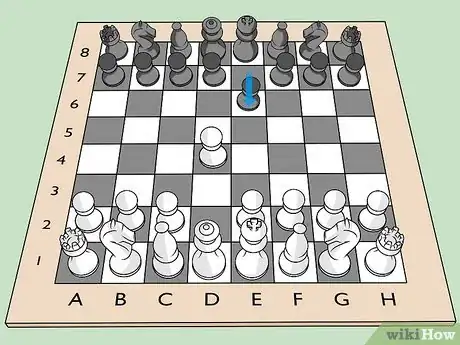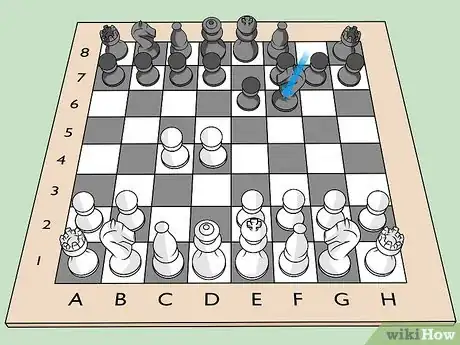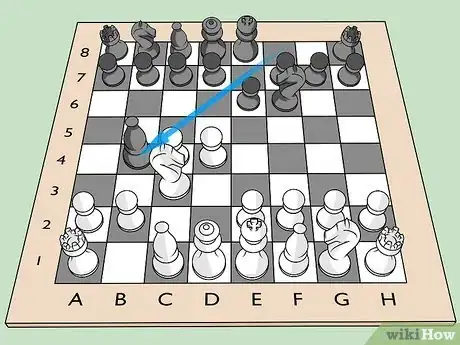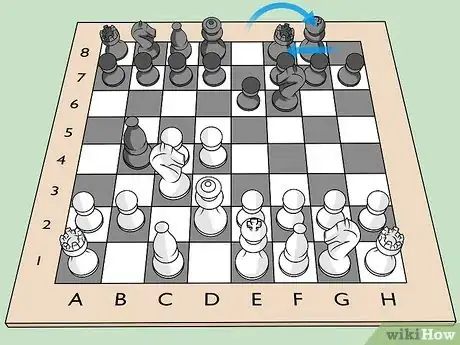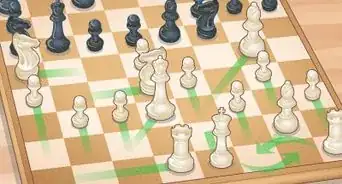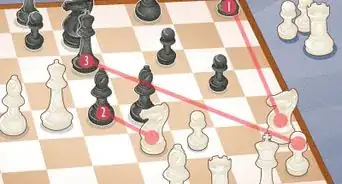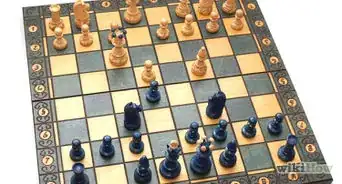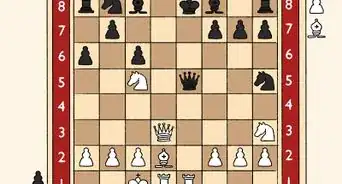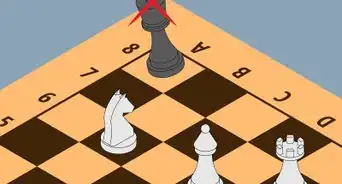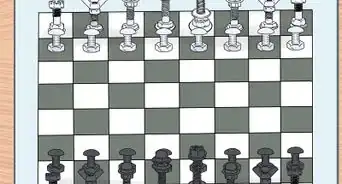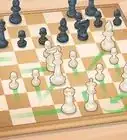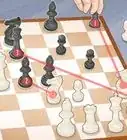This article was co-authored by Sahaj Grover and by wikiHow staff writer, Hunter Rising. Sahaj Grover is a Chess Grandmaster, World Champion, and coach, who attained his Grandmaster title at the age of 16. He has been a World Junior Bronze Medalist, World U10 Champion, South African Open 2017 & 2018 Champion, and the Winner of the Arnold Classic 2018 & 2019. Sahaj is known for dynamic attacking skills and being an excellent endgame player.
There are 9 references cited in this article, which can be found at the bottom of the page.
wikiHow marks an article as reader-approved once it receives enough positive feedback. In this case, 85% of readers who voted found the article helpful, earning it our reader-approved status.
This article has been viewed 335,981 times.
The opening moves of chess are crucial for setting up the board for the rest of the game. While the player with the white pieces always goes first, there are still many strategies and defenses you can set up if you’re playing as the black pieces. There are a variety of different openings you can make after the white player makes their first move, but some of the strongest offensive plays are the Sicilian Defense and the French Defense. If you want to take a defensive approach, use the Nimzo-Indian Defense to protect your king.
Note: These openings only follow the mainline plays for the openings and do not cover variations, so your opponent may make different moves than what’s listed and change your strategy.
Steps
The Sicilian Defense
-
1Move your pawn to c5 to assert control over the d4 space. During white’s opening move, they’ll usually move a pawn to e4 to take control of the center of the board. Take the pawn that’s in front of the bishop on the queen’s side and move it forward 2 spaces to c5. You can capture pieces on either b4 or d4, which prevents your opponent from moving another piece to the center.[1]
- The white player will usually move the knight on their king’s side to f3 to defend the d4 and e5.
-
2Put the queen’s pawn on d6 to protect the center squares. After white’s second play, move the pawn in front of your queen 1 space forward so it’s on d6. That way, you’re protecting the first pawn you moved as well as defending the e5 square in the center of the board so your opponent can’t move there without getting captured.[2]
- White’s next move is usually moving their queen’s pawn to d4 so they control 2 squares in the center.
Tip: Moving your pawns to c5 and d6 creates a diagonal barrier on your queen’s side to help build your defenses and limit your opponent’s movement on that side of the board.
Advertisement -
3Capture the pawn at d4 with your pawn from c5. Move the pawn on c5 diagonally toward your opponent’s pawn on d4 and remove it from the board. While your pawn’s now at risk for an attack, you and your opponent now have even control over the center of the board.[3]
- Your opponent will typically capture the pawn you just moved with their knight so they have control over the center again.
-
4Move the king’s knight to f6 to put pressure on the center. Take the knight on g8, on the king’s side of the board, and move it to f6. With your knight there, you now have pressure on your opponent’s pawn at e4 and the empty square at d5.[4]
- The white player will want to defend the pawn so you can’t capture it, so they’ll move their queen’s knight to c3. That way, if you capture their pawn, they can capture your knight.
-
5Develop your queen’s knight to c6 to force your opponent to attack. Move your knight from b8 to c6 so it can access the center of the board. From this position, your opponent may capture the knight, but they will put themselves at risk of being captured by a pawn.[5]
- You may also move the pawn at a7 to a6 to help defend your king if you’d like.
- You could also move your pawn at g7 to g6 so you can move the king’s bishop out of the back row. That way, you can castle on the king’s side.
The French Defense
-
1Open with your pawn to e6. When the white opens to e4, move the pawn that’s in front of your king 1 space forward to e6. That way, your bishop is free to get out of the back row later on in the game and you’re defending the d5 center square so your opponent won’t put pieces on it.[6]
- Your opponent will try to control more of the center by moving their queen’s pawn to d4.
-
2Put the pawn from d7 onto d5 to hold a center square. Move the pawn that’s in front of your queen 2 spaces forward so it’s in front of your opponent’s pawn. You now have control over a center square and have the opportunity to capture the pawn on e4 if you want.[7]
- Your opponent will want to protect their pawn, so they will move it forward to e5.
- The pawn on e6 will defend the pawn you just moved so other pieces are less likely to attack it.
Tip: Your king’s bishop now also has a long diagonal path that it can travel on to help defend the queen’s side of the board.
-
3Move a pawn to c5 to put pressure on the white pieces. Take the pawn that’s on c7 and thrust it forward 2 spaces so it lands on c5. Now you have put your opponent’s pawn on d4 at risk and have a large defensive wall on the queen’s side of the board so it’s harder for the white pieces to attack.[8]
- Your opponent will typically develop their king’s knight to f3 to defend the pawn you put at risk.
-
4Develop your knight to c6. Take the knight you have at b8 and move it to c6 so it’s behind your pawns. From this position, you can capture either of your opponent’s pawns at the center of the board. While you only have your pawn in the middle squares, your knight puts pressure on the other squares there.[9]
- As an additional level of protection, your opponent will move their pawn at c2 to c3 to defend the center squares.
-
5Move your queen to b6 to give yourself offensive options. There are many moves you can make after you move your knight, but one of the strongest you can make is moving your queen to b6. Your queen then puts pressure on the pawn at b2 and acts as another layer of protection for your pawn at c5.[10]
- Don’t capture the pawn at b2 during your next turn since your opponent could easily remove your queen with their bishop.
The Nimzo-Indian Defense
-
1Move the pawn in front of your king to e6. If your opponent opens the game by moving their queen’s pawn to d4, make your first move to e6. This limits your opponent from moving their pawn forward during their next turn since you could capture it. It also opens up your king’s bishop so it can move out of the back row.[11]
- The mainline strategy for your opponent is moving their pawn at c2 to c4 to protect d5.
-
2Develop the king’s knight to f6. Move the knight on g8 up to f6 so it’s right next to the pawn you moved during the first turn. The knight will help defend the d5 so your opponent’s pawn doesn’t move into it, but it will also allow it to access the king’s side of the board so your opponent can’t attack as easily.[12]
- Your opponent usually would move their queen’s knight from b1 to c3.
-
3Move the king’s bishop to b4 to pin your opponent’s knight. Take the bishop next to your king and move it diagonally to the b4 square so it’s next to your opponent’s pawn. Your opponent won’t be able to move their knight since you would be able to capture their king during your next turn.[13]
- Your opponent will most likely move their queen to e2 so they can capture your bishop if you decide to capture their knight.
-
4Castle on the king’s side to build your defense. Place your king on g8 and move the rook at h8 to the right until it’s in f8. Now your king is protected by a row of pawns and your rook so it’s harder to capture. Keep your king protected near the corner throughout the rest of the game so it’s harder for your opponent to attack it.[14]
Expert Q&A
Did you know you can get expert answers for this article?
Unlock expert answers by supporting wikiHow
-
QuestionIs black or white better in chess?
 Sahaj GroverSahaj Grover is a Chess Grandmaster, World Champion, and coach, who attained his Grandmaster title at the age of 16. He has been a World Junior Bronze Medalist, World U10 Champion, South African Open 2017 & 2018 Champion, and the Winner of the Arnold Classic 2018 & 2019. Sahaj is known for dynamic attacking skills and being an excellent endgame player.
Sahaj GroverSahaj Grover is a Chess Grandmaster, World Champion, and coach, who attained his Grandmaster title at the age of 16. He has been a World Junior Bronze Medalist, World U10 Champion, South African Open 2017 & 2018 Champion, and the Winner of the Arnold Classic 2018 & 2019. Sahaj is known for dynamic attacking skills and being an excellent endgame player.
Chess Grandmaster
-
QuestionWhich Sicilian defense is best?
 Sahaj GroverSahaj Grover is a Chess Grandmaster, World Champion, and coach, who attained his Grandmaster title at the age of 16. He has been a World Junior Bronze Medalist, World U10 Champion, South African Open 2017 & 2018 Champion, and the Winner of the Arnold Classic 2018 & 2019. Sahaj is known for dynamic attacking skills and being an excellent endgame player.
Sahaj GroverSahaj Grover is a Chess Grandmaster, World Champion, and coach, who attained his Grandmaster title at the age of 16. He has been a World Junior Bronze Medalist, World U10 Champion, South African Open 2017 & 2018 Champion, and the Winner of the Arnold Classic 2018 & 2019. Sahaj is known for dynamic attacking skills and being an excellent endgame player.
Chess Grandmaster One of the best lines for Sicilian Defense is called the Najdorf, and it's often used by higher-rated players because it hasn't been defeated. The Sicilian Taimanov is another good one. However, I wouldn't recommend these lines to a beginner because they're highly complicated. If you're just getting started, it's best to play a line that doesn't require so many variations, because it's easy to get overwhelmed when it's all combined.
One of the best lines for Sicilian Defense is called the Najdorf, and it's often used by higher-rated players because it hasn't been defeated. The Sicilian Taimanov is another good one. However, I wouldn't recommend these lines to a beginner because they're highly complicated. If you're just getting started, it's best to play a line that doesn't require so many variations, because it's easy to get overwhelmed when it's all combined. -
QuestionHow many types of chess openings are there?
 Sahaj GroverSahaj Grover is a Chess Grandmaster, World Champion, and coach, who attained his Grandmaster title at the age of 16. He has been a World Junior Bronze Medalist, World U10 Champion, South African Open 2017 & 2018 Champion, and the Winner of the Arnold Classic 2018 & 2019. Sahaj is known for dynamic attacking skills and being an excellent endgame player.
Sahaj GroverSahaj Grover is a Chess Grandmaster, World Champion, and coach, who attained his Grandmaster title at the age of 16. He has been a World Junior Bronze Medalist, World U10 Champion, South African Open 2017 & 2018 Champion, and the Winner of the Arnold Classic 2018 & 2019. Sahaj is known for dynamic attacking skills and being an excellent endgame player.
Chess Grandmaster There are over 100 different openings in chess, but you don't have to memorize them all. To have a good repertoire, you should probably know about 15-20 openings, and those should include both black and white. However, it's also really important to know a proper response to each of the openings. That way, if your opponent opens with e5, Sicilian, Ilya Kan, or French, you'll know what to do.
There are over 100 different openings in chess, but you don't have to memorize them all. To have a good repertoire, you should probably know about 15-20 openings, and those should include both black and white. However, it's also really important to know a proper response to each of the openings. That way, if your opponent opens with e5, Sicilian, Ilya Kan, or French, you'll know what to do.
Warnings
- Avoid playing the same opening every game or else your opponent will predict your moves and counter them.⧼thumbs_response⧽
References
- ↑ http://www.caissa.com/chess-openings/sicilian-defense.php
- ↑ http://www.caissa.com/chess-openings/sicilian-defense.php
- ↑ http://www.caissa.com/chess-openings/sicilian-defense.php
- ↑ https://youtu.be/qzydxPgPKzs?t=237
- ↑ https://youtu.be/qzydxPgPKzs?t=306
- ↑ https://www.flyintobooks.com/the-french-defense-learn-a-top-3-chess-opening-for-black/
- ↑ https://www.flyintobooks.com/the-french-defense-learn-a-top-3-chess-opening-for-black/
- ↑ https://youtu.be/rTNN7-Wwpzs?t=492
- ↑ https://www.flyintobooks.com/the-french-defense-learn-a-top-3-chess-opening-for-black/
About This Article
To win chess openings playing black with the French Defense, start by moving your king pawn 1 space forward to e6. When moving your queen pawn, move it to d5, pushing your pawn 2 spaces forward. Next, move your pawn to c5, move your knight to c6, and move your queen to b6 to put pressure on White's pieces. For more on winning chess openings, like the Sicilian Defense, read on!
